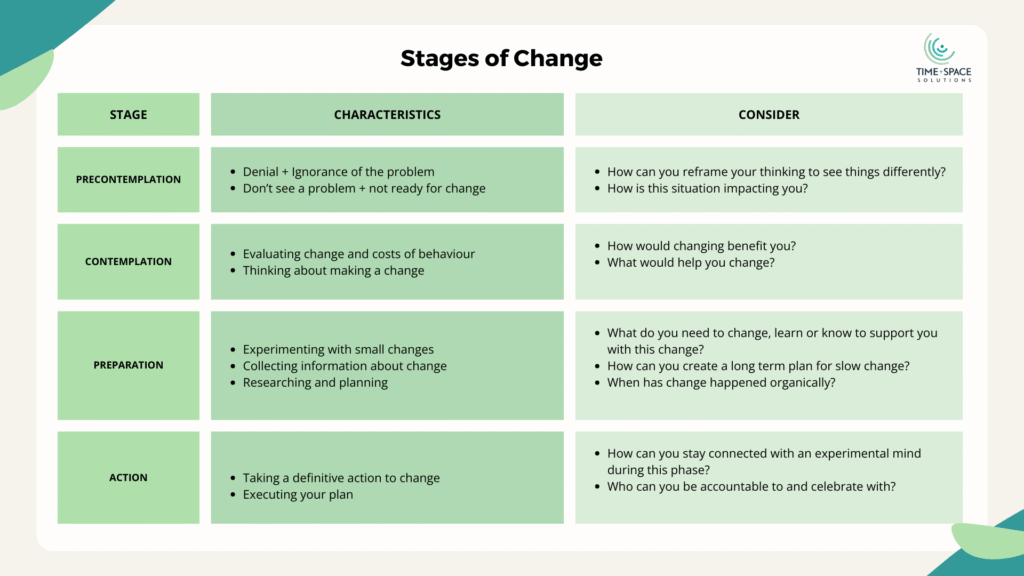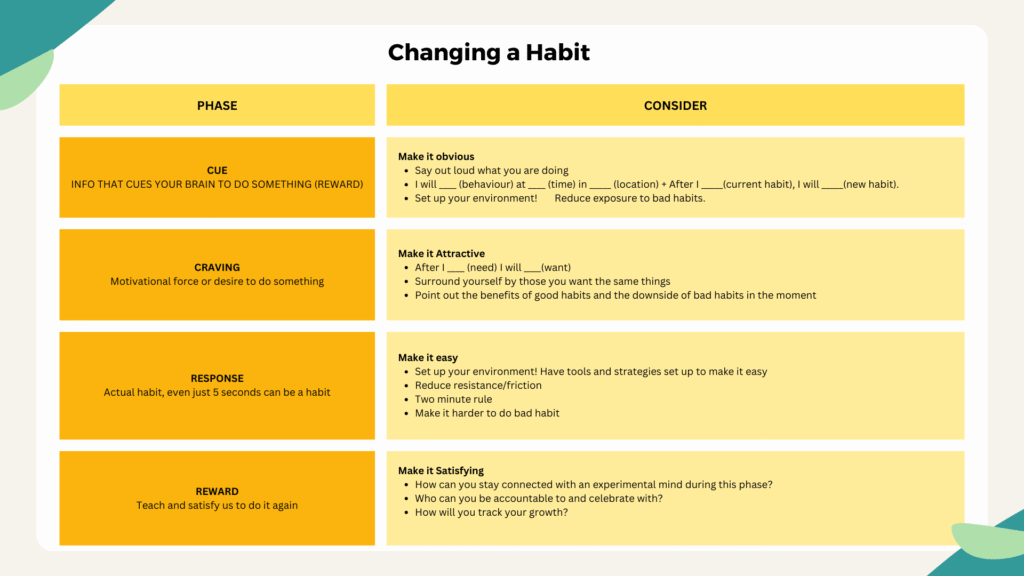There are different ways to approach habit changing. Over the years, I’ve worked with people who go too hard, too fast then burn out, or give up after missing a day. Then there are people who make pain stakingly slow progress only to go back to their old ways. In this blog I will lay out the key factors that can have the biggest impact for you to create positive, healthy habits. Remember there is no one size fits all so see it as an experiment figuring out what’s best for you.

One great perspective to embody is that true change happens on a micro level. Atomic Habits by James Clear provides a framework for how to both utilize the brain functions and gives strategies that work best for your personality. This approach forces you to be present and notice the very small changes. I would also say that it’s important to see any change as growth and an experiment rather than trying to reach a goal. This allows the brain to keep going even after something doesn’t work out.
Another thing to consider before even setting your habit goals is to take some time to connect with yourself and see what matters, what’s important to you, who you want to be in the world and what do you want to create. THEN look at the habits that you would need to establish to be that person. When we begin with values and who we want to be, we are more likely to follow through with our desires, aspirations and intentions.
Stages of Change
The next thing to be aware of is where you are in the stages of change. Motivational interviewing uses this process to help people overcome addictions. I find it helpful for anyone wanting to create change in their life. It gives you a reference point to know where you are at in the process even before you start implementing a habit change.
Looking at the table below you will see that there are two stages before you even take action.

This is important because often people will try to jump into changing a habit without proper preparation. On the flipside are people who spend too much time planning and not taking any action. I know for myself this process happens organically and I slowly gather information while I implement a micro aspect of the habit I want to introduce. Over time the habit improves as I have the plan I need to master the habit.
For example, I started going to the gym randomly and moved to going two times a week. It didn’t matter what I did, as long as I went. Next I became more international and focused on legs one day and upper body the next. During this time I was finding great videos of exercises I wanted to do. Now, slowly, I’m putting them together in a document and will eventually create a work out plan and go to the gym three times a week. This process has been happening for about 7 months now and will probably continue for another 3 before I feel I have a routine I like. And of course there will always be room for improvement, variety and trying new options.
Consider where you are in the stages of change for a particular area in your life that you want to address. How can you move along and ensure that you have what you need to take action and maintain the change.
Habit Cycle
The next helpful aspect of habit changing is knowing the cycle of a habit. When the conditions are right new habits form with ease. Check out the chart below to see some ways that you can improve each stage of the habit cycle.

The Most Important Things to Remember
I feel with both my own personal experience and working with clients that the following are key to establishing any new habits.
- Have an accountability partner and plan. This is probably the most helpful thing you can do. Write a contract if necessary to really take it to the next level. This helps the subconscious mind to take it more seriously and you don’t just have to answer to yourself. We are social beings so this is a natural way to create connection, consistency and motivation.
- Setting up your physical environment to support the new habit. This means clearing the clutter, getting organized, creating zones for specific habits and activities as well as making it easy to access the tools you need to perform your habits and routines.
- Research, reflect and prepare. Reflect on how you would like to approach this new habit and prepare anything you may need. Take some time to do research and gather information so that you can learn and gain the skills needed to execute the habit. For example you want to meditate, read a book about it, watch some videos, find some guided meditation tracks.
- Emotional Barriers. There’s usually something inside of us that needs your attention and once you can connect with your emotions and the stories that come with you, you have an opportunity to transform them. Check out the focusing technique as one way to go through this process.
- Just do it! That saying is true and it works. I tell myself just 2 minutes when I don’t want to do the dishes, which is 80% of the time. Once you get started, then it’s not as big of a deal, and eventually you will do it with ease.
- Track your growth. Whether it’s checking it off on a habit tracking chart or writing your internal growth in a journal it’s important to see the progress so that you stay motivated and connected to the process. It’s too easy to focus on the negative and think you are not changing, when in reality you are.
When It Doesn’t Work
It’s important to note that there are other factors at play and this isn’t a cut and dry process. For example, if you are dealing with unpredictable health conditions that affect what you can do at any given moment, trying to change a habit requires a slightly different approach. Maybe you struggle with flareups of arthritis and are unable to get up in 5 minutes and need 30 minutes instead. That’s ok, just adapt and shift the timing of things. Instead of doing your usual 20 minute walk it may only be 5 minutes. The key is to be consistent and stay connected to the benefits of what you are doing.
Illnesses, effects of trauma, and life circumstances add on and can make it more challenging to what is needed to change a habit. When dealing with these, it’s important to still focus on TINY baby steps, being consistent and, most of all, dealing with your internal landscape. That means your thoughts, beliefs, emotions and past experience that still affect you. When we have big barriers in life, it’s an opportunity to look within and see what needs our attention and what can be released. Going through this process is very healing regardless of what challenges you face.
It’s not easy, but necessary to accept these challenging elements and just know that it might take a bit longer than if you didn’t have them. The cool thing is that when you do accomplish what you set out to do, it means so much that you did it and worth every effort and tear.
Getting support to face these challenges can be helpful so that you don’t give up so fast when they hit you in the face. Consider finding a personal trainer or healing practitioner to help you dive into your inner wounds and release trapped energy that is causing you many barriers. I truly believe, where there is a will there is a way, so be open to possibilities and what is out there that you may not have considered.

